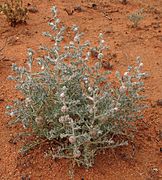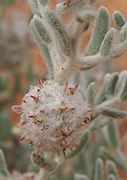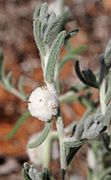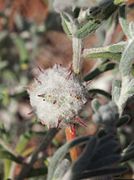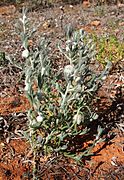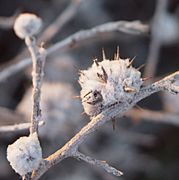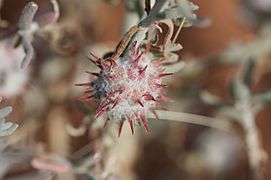Dissocarpus paradoxus facts for kids
Quick facts for kids Dissocarpus paradoxus |
|
|---|---|
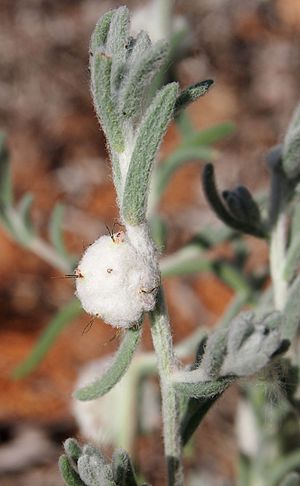 |
|
| Dissocarpus paradoxus flower | |
| Scientific classification | |
| Genus: |
Dissocarpus
|
| Species: |
paradoxus
|
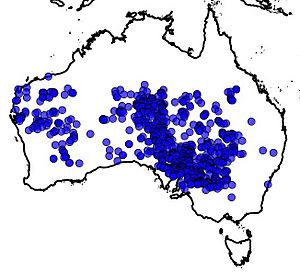 |
|
Dissocarpus paradoxus is a type of shrub that grows in inland Australia. It's also known by fun common names like cannonball burr or curious saltbush. This plant is special because it can live in tough, salty environments.
Contents
What it Looks Like
Dissocarpus paradoxus has a few common names, including Cannon Ball Burr, Ball Bindyi, Curious Saltbush, and Hard-head Bassia. This plant is usually a short-lived perennial shrub, meaning it lives for more than two years but not forever. It can grow up to 50 centimeters (about 20 inches) tall.
Its leaves are a bit hairy and can be up to 15 millimeters (about half an inch) long. Sometimes, the plant grows flat along the ground instead of standing tall.
The flowers are white and look like woolly heads. You'll find about 8 to 16 flowers grouped together at the base of the leaves. These flowers usually appear from early spring through summer, but you might spot them at other times too.
The fruit of the Dissocarpus paradoxus is quite unique. It's round, dense, and feels like a hard, woolly ball, about 10 millimeters (less than half an inch) across. Many spiky ridges stick out from this woolly ball. When this hard, woody fruit breaks down, it releases the seeds. There's a slightly different type called Dissocarpus paradoxus Var. latifolia, which has wider, oblong-shaped leaves.
Where it Grows and How it Lives
This plant grows in many different woodland areas across Australia. You can find it in places with mallee trees, mulga trees, and other native Australian plants like bimble box and gidgee. It also lives in areas with bladder saltbush and black bluebush.
Dissocarpus paradoxus prefers to grow in red earth and brown soils that have a lot of salt. Plants in the Saltbush family, like this one, are very good at living in soils with high levels of salt and other minerals. Even in these tough conditions, they can still produce many seeds.
These plants don't live for a very long time. While you might find many of them in one spot, how many there are can change a lot depending on the weather and season. Even though some animals might eat Dissocarpus paradoxus, it's not their favorite food compared to other plants.
Plant Family Tree
Dissocarpus paradoxus has had a few different scientific names over time, like Bassia paradoxa and Sclerolaena paradoxa. It belongs to the Saltbush family, which is a very large group of plants. Many plants in this family grow in areas where the soil has a lot of salt.
Sometimes, the Saltbush family (Chenopodiaceae) is considered a part of a bigger family called Amaranthaceae. In Australia, these two families are often grouped together and called 'cheno-ams'. Long ago, some Indigenous groups in Australia used the leaves and seeds of 'cheno-ams' as a food source.
How it's Protected
Good news! Dissocarpus paradoxus is not considered to be in danger. It's listed as 'of least concern' in Queensland and the Northern Territory, and 'not threatened' in Western Australia. This means there are plenty of these plants around.
Image gallery


